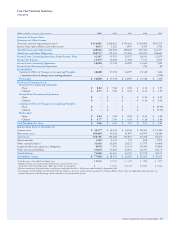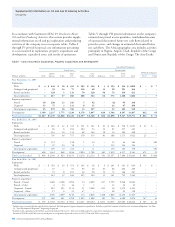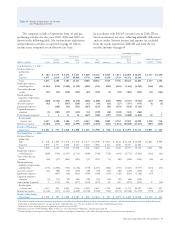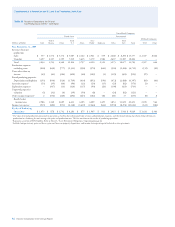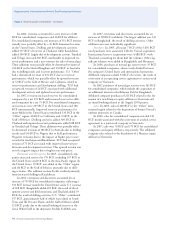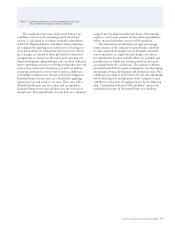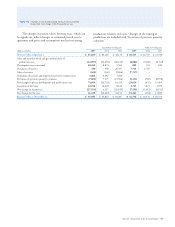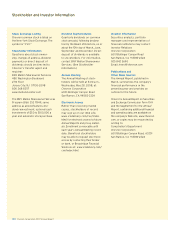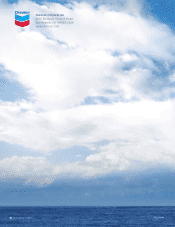Chevron 2007 Annual Report Download - page 98
Download and view the complete annual report
Please find page 98 of the 2007 Chevron annual report below. You can navigate through the pages in the report by either clicking on the pages listed below, or by using the keyword search tool below to find specific information within the annual report.
96
In 2006, net revisions increased reserves by 39 million
and 84 million barrels for worldwide consolidated companies
and equity affiliates, respectively. International consolidated
companies accounted for the net increase of 39 million barrels.
The largest upward net revisions were 61 million barrels in
Indonesia and 27 million barrels in Thailand. In Indonesia,
the increase was the result of infill drilling and improved
steamflood performance. The upward revision in Thailand
reflected additional drilling and development activity during
the year. These upward revisions were partially offset by
reductions in reservoir performance in Nigeria and the United
Kingdom, which decreased reserves by 43 million barrels and
by 32 million barrels, respectively. Most of the upward revi-
sion for affiliated companies was related to a 60 million-barrel
increase in TCO as a result of improved reservoir performance.
In 2007, net revisions decreased reserves by 146 million
barrels for worldwide consolidated companies and increased
reserves by 103 million barrels for equity affiliates. For con-
solidated companies, the largest downward net revisions were
89 million barrels in Africa and 66 million barrels in Indonesia.
In Africa, the decrease was mainly based on field performance
data for fields in Nigeria and the effect of higher year-end
prices in Angola and the Republic of the Congo. In Indonesia,
the decline also reflected the impact of higher year-end
prices. Higher prices also resulted in downward revisions in
Karachaganak and Azerbaijan. For equity affiliates, most of
the upward revision was related to a 92 million-barrel increase
for the Tengiz Field in TCO and an 11 million-barrel increase
for Petroboscan in Venezuela, both as a result of improved
reservoir performance. At TCO, the upward revision was
tempered by the negative impact of higher year-end prices.
Improved Recovery In 2005, improved recovery increased
liquids volumes worldwide by 203 million barrels for con-
solidated companies. International areas accounted for 142
million barrels of the increase. Indonesia added 42 million
barrels due to improved performance. Reserve additions of
67 million barrels in Africa occurred primarily in Angola and
resulted from infill drilling, wells workovers and secondary
recovery from gas injection. Additions of 29 million barrels
in the “Other” international area were mainly attributable to
improved waterflood performance offshore eastern Canada.
An increase of 61 million barrels occurred in the United
States, primarily in California due to improved performance
on a large heavy oil field under thermal recovery.
In 2006, improved recovery increased liquids volumes
worldwide by 83 million barrels for consolidated companies.
Reserves in the United States increased 52 million barrels,
with California representing 49 million barrels of the total
increase due to steamflood expansion and revised modeling
activities. Internationally, improved recovery increased reserves
by 31 million barrels, with no single country accounting for an
increase of more than 10 million barrels.
In 2007, improved recovery increased liquids volumes
by 20 million barrels worldwide. No addition was indi-
vidually significant.
Extensions and Discoveries In 2005, extensions and dis-
coveries increased liquids volumes worldwide by 184 million
barrels for consolidated companies. The largest increase was
49 million barrels in Nigeria, reflecting new development
drilling, including in the Agbami Field, among others. New
field developments in Brazil contributed another 41 million
barrels of discoveries. In the United States, the 44 million-
barrel addition was associated mainly with the initial
booking of reserves for the Blind Faith Field in the deepwater
Gulf of Mexico.
In 2006, extensions and discoveries increased liquids
volumes worldwide by 107 million barrels for consolidated
companies. Reserves in Nigeria increased by 27 million barrels
due in part to the initial booking of reserves for the Aparo
Field. Additional drilling activities contributed 19 million
barrels in the United Kingdom and 14 million barrels in
Argentina. In the United States, the Gulf of Mexico added
25 million barrels, mainly the result of the initial booking of
the Great White Field in the deepwater Perdido Fold Belt area.
In 2007, extensions and discoveries increased liquids vol-
umes by 60 million barrels worldwide. The largest additions
were 25 million barrels in the U.S. Gulf of Mexico, mainly for
the deepwater Tahiti and Mad Dog fields.
Purchases In 2005, the acquisition of 572 million barrels
of liquids related solely to the acquisition of Unocal in August.
About three-fourths of the 376 million barrels acquired in
the international areas were represented by volumes in
Azerbaijan and Thailand. Most volumes acquired in the
United States were in Texas and Alaska.
In 2006, acquisitions increased liquids volumes world-
wide by 21 million barrels for consolidated companies and
119 million barrels for equity affiliates. For consolidated
companies, the amount was mainly the result of new agree-
ments in Nigeria, which added 13 million barrels of reserves.
The other-equity-affiliates quantity reflects the result of the
conversion of Boscan and LL-652 operations to joint stock
companies in Venezuela.
In 2007, acquisitions of 316 million barrels for equity
affiliates related to the formation of a new Hamaca equity
affiliate in Venezuela.
Sales In 2005, sales of 58 million barrels in the “Other”
international area related to the disposition of the former
Unocal operations onshore in Canada.
In 2006, sales decreased reserves by 15 million barrels
due to the conversion of the LL-652 risked service agreement
to a joint stock company in Venezuela.
In 2007, affiliated company sales of 432 million barrels
related to the dissolution of a Hamaca equity affiliate
in Venezuela.
Supplemental Information on Oil and Gas Producing Activities



